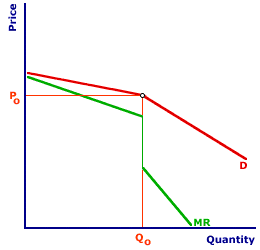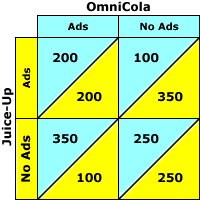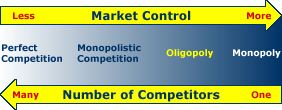
|
|
HHI: The common abbreviation for the Herfindahl-Hirshman index (or the Herfindahl index), which is a measure of concentration of the production in an industry that's calculated as the sum of the squares of market shares for each firm. This is an alternative method of summarizing the degree to which an industry is oligopolistic and the relative concentration of market power held by the largest firms in the industry. The Herfindahl index gives a better indication of the relative market control of the largest firms than can be found with the four-firm and eight-firm concentration ratios.
Visit the GLOSS*arama
|
|


|

|
                           OLIGOPOLY: A market structure characterized by a small number of large firms that dominate the market, selling either identical or differentiated products, with significant barriers to entry into the industry. This is one of four basic market structures. The other three are perfect competition, monopoly, and monopolistic competition. Oligopoly dominates the modern economic landscape, accounting for about half of all output produced in the economy. Oligopolistic industries are as diverse as they are widespread, ranging from breakfast cereal to cars, from computers to aircraft, from television broadcasting to pharmaceuticals, from petroleum to detergent. Oligopoly is a market structure characterized by a small number of relatively large firms that dominate an industry. The market can be dominated by as few as two firms or as many as twenty, and still be considered oligopoly. With fewer than two firms, the industry is monopoly. As the number of firms increase (but with no exact number) oligopoly becomes monopolistic competition.Because an oligopolistic firm is relatively large compared to the overall market, it has a substantial degree of market control. It does not have the total control over the supply side as exhibited by monopoly, but its capital is significantly greater than that of a monopolistically competitive firm. Relative size and extent of market control means that interdependence among firms in an industry is a key feature of oligopoly. The actions of one firm depend on and influence the actions of another. Such interdependence creates a number of interesting economic issues. One is the tendency for competing oligopolistic firms to turn into cooperating oligopolistic firms. When they do, inefficiency worsens, and they tend to come under the scrutiny of government. Alternatively, oligopolistic firms tend to be a prime source of innovations, innovations that promote technological advances and economic growth. Like much of the imperfection that makes up the real world, there is both good and bad with oligopoly. The challenge in economics is, of course, to promote the good and limit the bad. CharacteristicsThe three most important characteristics of oligopoly are: (1) an industry dominated by a small number of large firms, (2) firms sell either identical or differentiated products, and (3) the industry has significant barriers to entry.- Small Number of Large Firms: An oligopolistic industry is dominated by a small number of large firms, each of which is relatively large compared to the overall size of the market. This generates substantial market control, the extent of market control depending on the number and size of the firms.
- Identical or Differentiated Products: Some oligopolistic industries produce identical products, while others produce differentiated products. Identical product oligopolies tend to process raw materials or intermediate goods that are used as inputs by other industries. Notable examples are petroleum, steel, and aluminum. Differentiated product oligopolies tend to focus on consumer goods that satisfy the wide variety of consumer wants and needs. A few examples of differentiated oligopolistic industries include automobiles, household detergents, and computers.
- Barriers to Entry: Firms in a oligopolistic industry attain and retain market control through barriers to entry. The most common barriers to entry include patents, resource ownership, government franchises, start-up cost, brand name recognition, and decreasing average cost. Each of these make it extremely difficult, if not impossible, for potential firms to enter an industry.
BehaviorAlthough oligopolistic industries tend to be diverse, they also tend to exhibit several behavioral tendencies: (1) interdependence, (2) rigid prices, (3) nonprice competition, (4) mergers, and (5) collusion. - Interdependence: Each oligopolistic firm keeps a close eye on the activities of other firms in the industry. Decisions made by one firm invariably affect others and are invariably affected by others. Competition among interdependent oligopoly firms is comparable to a game or an athletic contest. One team's success depends not only on its own actions but on the actions of its competitor. Oligopolistic firms engage in competition among the few.
- Rigid Prices: Many oligopolistic industries (not all, but many) tend to keep prices relatively constant, preferring to compete in ways that do not involve changing the price. The prime reason for rigid prices is that competitors are likely to match price decreases, but not price increases. As such, a firm has little to gain from changing prices.
- Nonprice Competition: Because oligopolistic firms have little to gain through price competition, they generally rely on nonprice methods of competition. Three of the more common methods of nonprice competition are: (a) advertising, (b) product differentiation, and (c) barriers to entry. The goal for most oligopolistic firms is to attract buyers and increase market share, while holding the line on price.
- Mergers: Oligopolistic firms perpetually balance competition against cooperation. One way to pursue cooperation is through merger--legally combining two separate firms into a single firm. Because oligopolistic industries have a small number of firms, the incentive to merge is quite high. Doing so then gives the resulting firm greater market control.
- Collusion: Another common method of cooperation is through collusion--two or more firms that secretly agree to control prices, production, or other aspects of the market. When done right, collusion means that the firms behave as if they are one firm, a monopoly. As such they can set a monopoly price, produce a monopoly quantity, and allocate resources as inefficiently as a monopoly. A formal method of collusion, usually found among international produces is a cartel.
Kinked-Demand Curve| Kinked-Demand Curve |  |
Short-run production activity of an oligopolistic firm is often illustrated by a kinked-demand curve, such as the one presented in the exhibit to the right. A kinked-demand curve has two distinct segments with different elasticities that join to form a kink. The primary use of the kinked-demand curve is to explain price rigidity in oligopoly. The two segments are: (1) a relatively more elastic segment for price increases and (2) a relatively less elastic segment for price decreases. The relative elasticities of these two segments is directly based on the interdependent decision-making of oligopolistic firms.The kink of the demand curve exists at the current quantity (Qo) and price (Po). - Because competing firms ARE NOT likely to match the price increases of an oligopolistic firm, the firm is likely to loose customers and market share to the competition. Small price increases result in relatively large decreases in quantity demanded.
- However, because competing firms ARE likely to match the price decreases of an oligopolistic firm, the firm is unlikely to gain customers and market share from the competition. Large price decreases are needed to gain relatively small increases in quantity demanded.
Each segment of the demand curve has its own marginal revenue segment. This actually means that the marginal revenue curve facing an oligopolistic firm, labeled MR in the exhibit, contains three distinct segments.- Top Segment: The flatter top portion of the marginal revenue corresponds to the more elastic demand generated by price increases.
- Bottom Segment: The steeper bottom portion of the marginal revenue corresponds to the less elastic demand generated by price decreases.
- Middle Segment: The vertical middle segment connecting the top and bottom segments that occurs at the output quantity Qo corresponds with the kink of the curve.
The vertical segment is key to the analysis of short-run production by an oligopolistic firm. It means that the firm can equate marginal revenue with marginal cost, and thus maximize profit, even though marginal cost increases or decreases. If marginal cost increases a bit, the profit-maximizing price and quantity remain at Po and Qo. If marginal cost decreases a bit, the profit-maximizing price and quantity also remain at Po and Qo. Game Theory| Soft Drink Advertising |  |
A technique often used to analyze interdependent behavior among oligopolistic firms is game theory. Game theory illustrates how the choices between two players affect the outcomes of a "game." This analysis illustrates two firms cooperating through collusion are better off than if they compete.The exhibit to the right illustrates the alternative facing two oligopolistic firms, Juice-Up and OmniCola, as they ponder the prospects of advertising their products. - In the top left quadrant, if OmniCola and Juice-Up BOTH decide to advertise, then each receives $200 million in profit.
- However, in the lower right quadrant, if NEITHER OmniCola or Juice-Up decide to advertise, then each receives $250 million in profit. They receive more because they do not incur any advertising expense.
- Alternatively, as shown in the lower left quadrant, if OmniCola advertises but Juice-Up does not, then OmniCola receives $350 million in profit and Juice-Up receives only $100 in profit. OmniCola receives a big boost in profit because its advertising attracts customers away from Juice-Up.
- But, as shown in the top right quadrant, if Juice-Up advertises and OmniCola does not, then Juice-Up receives $350 million in profit and OmniCola receives only $100 in profit. Juice-Up receives a big boost in profit because its advertising attracts customers away from OmniCola.
Game theory indicates that the best choice for OmniCola is to advertise, regardless of the choice made by Juice-Up. And Juice-Up faces EXACTLY the same choice. Regardless of the decision made by OmniCola, Juice-Up is wise to advertise.The end result is that both firms decide to advertise. In so doing, they end up with less profit ($200 million each), than if they had colluded and jointly decided not to advertise ($250 million each). The Bad of OligopolyLike much of life, oligopoly has both bad and good. The bads are that oligopoly: (1) tends to be inefficient in the allocation of resources and (2) promotes the concentration, and thus inequality, of income and wealth.- Inefficiency: First and foremost, oligopoly does NOT efficiently allocate resources. Like any firm with market control, an oligopoly charges a higher price and produces less output than the efficiency benchmark of perfect competition. In fact, oligopoly tends to be the worst efficiency offender in the real world, because perfect competition does not exist, monopolistic competition inefficiency is minor, and monopoly inefficiency has the potential for being so bad that it is inevitably subject to corrective government regulation.
- Concentration: Another bad is that oligopoly tends to increase the concentration of wealth and income. This is not necessarily bad, but it can be self-reinforcing and inhibit pursuit of the microeconomic goal of equity. While the concentration of wealth is not bad unto itself, such wealth can then be used (or abused) to exert influence over the economy, the political system, and society, which might not be beneficial for society as a whole.
The Good of OligopolyWith the bad comes a little good. The two most noted goods from oligopoly are (1) by developing product innovations and (2) taking advantage of economies of scale.- Innovations: Of the four market structures, oligopoly is the one most likely to develop the innovations that advance the level of technology, expand production capabilities, promote economic growth, and lead to higher living standards. Oligopoly has both the motive and the opportunity to pursue innovation. Motive comes from interdependent competition and opportunity arises from access to abundant resources.
- Economies of Scale: Oligopoly firms are also able to take advantage of economies of scale that reduce production costs and prices. As large firms, they can "mass produce" at low average cost. Many modern goods--including cars, computers, aircraft, and assorted household products--would be significantly more expensive if produced by a large number of small firms rather than a small number of large firms.
The Other Three Market Structures| Market Structure Continuum |  |
Oligopoly is one of four common market structures. The other three are: perfect competition monopoly, and monopolistic competition. The exhibit to the right illustrates how these four market structures form a continuum based on the relative degree of market control and the number of competitors in the market. In the middle of the market structure continuum, near the right end, is oligopoly, characterized by a few competitors and extensive market control.- Perfect Competition: To the far left of the market structure continuum is perfect competition, characterized by a large number of relatively small competitors, each with no market control. Perfect competition is an idealized market structure that provides a benchmark for efficiency.
- Monopoly: To the far right of the market structure continuum is monopoly, characterized by a single competitor and extensive market control. Monopoly contains a single seller of a unique product with no close substitutes. The demand for monopoly output is THE market demand.
- Monopolistic Competition: Also in the middle of the market structure continuum, but residing closer to perfect competition, is monopolistic competition, characterized by a large number of relatively small competitors, each with a modest degree of market control. A substantial number of real world markets fit the characteristics of monopolistic competition.
On the surface, oligopoly and monopolistic competition seem quite different. Oligopoly contains a few large firms that dominate a market. Monopolistic competition contains a larger number of small firms, each with some, but not a lot of market control. However, monopolistic competition and oligopoly are actually the heart and soul of the market structure continuum.There is no clear-cut, obvious dividing line between monopolistic competition and oligopoly. While a three-firm industry is most assuredly an oligopoly and a 3,000 firm industry is most assuredly monopolistic competition, an industry with 30 firms might be considered either oligopoly or monopolistic competition. For example, convenience stores in a large city are undoubtedly monopolistically competitive. However, convenience stores in a smaller town might very well be oligopoly.

Recommended Citation:OLIGOPOLY, AmosWEB Encyclonomic WEB*pedia, http://www.AmosWEB.com, AmosWEB LLC, 2000-2025. [Accessed: July 18, 2025].
Check Out These Related Terms... | | | |
Or For A Little Background... | | | | | | | | | | | | | | |
And For Further Study... | | | | | | | | | | | |
Related Websites (Will Open in New Window)... | | |
Search Again?
Back to the WEB*pedia
|



|

|
PINK FADFLY
[What's This?]
Today, you are likely to spend a great deal of time calling an endless list of 800 numbers wanting to buy either a weathervane with a cow on top or a box of multi-colored, plastic paper clips. Be on the lookout for high interest rates.
Your Complete Scope
This isn't me! What am I?
|

|
|
The portion of aggregate output U.S. citizens pay in taxes (30%) is less than the other six leading industrialized nations -- Britain, Canada, France, Germany, Italy, or Japan.
|

|
|
"A winner is someone who recognizes his God-given talents, works his tail off to develop them into skills, and uses those skills to accomplish his goals. " -- Larry Bird, basketball player
|

|
ACBS
Accrediting Commission for Business Schools
|

|
|
Tell us what you think about AmosWEB. Like what you see? Have suggestions for improvements? Let us know. Click the User Feedback link.
User Feedback
|


|


